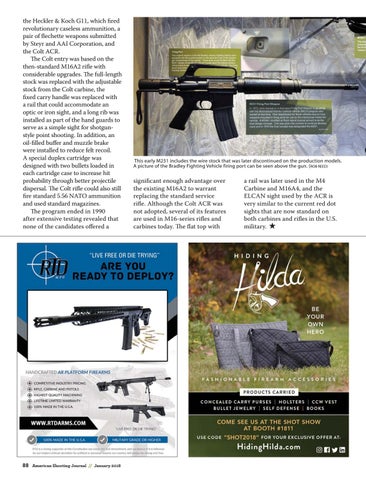the Heckler & Koch G11, which fired revolutionary caseless ammunition, a pair of flechette weapons submitted by Steyr and AAI Corporation, and the Colt ACR. The Colt entry was based on the then-standard M16A2 rifle with considerable upgrades. The full-length stock was replaced with the adjustable stock from the Colt carbine, the fixed carry handle was replaced with a rail that could accommodate an optic or iron sight, and a long rib was installed as part of the hand guards to serve as a simple sight for shotgunstyle point shooting. In addition, an oil-filled buffer and muzzle brake were installed to reduce felt recoil. A special duplex cartridge was designed with two bullets loaded in each cartridge case to increase hit probability through better projectile dispersal. The Colt rifle could also still fire standard 5.56 NATO ammunition and used standard magazines. The program ended in 1990 after extensive testing revealed that none of the candidates offered a
88
American Shooting Journal // January 2018
This early M231 includes the wire stock that was later discontinued on the production models. A picture of the Bradley Fighting Vehicle firing port can be seen above the gun. (ROB REED)
significant enough advantage over the existing M16A2 to warrant replacing the standard service rifle. Although the Colt ACR was not adopted, several of its features are used in M16-series rifles and carbines today. The flat top with
a rail was later used in the M4 Carbine and M16A4, and the ELCAN sight used by the ACR is very similar to the current red dot sights that are now standard on both carbines and rifles in the U.S. military.
